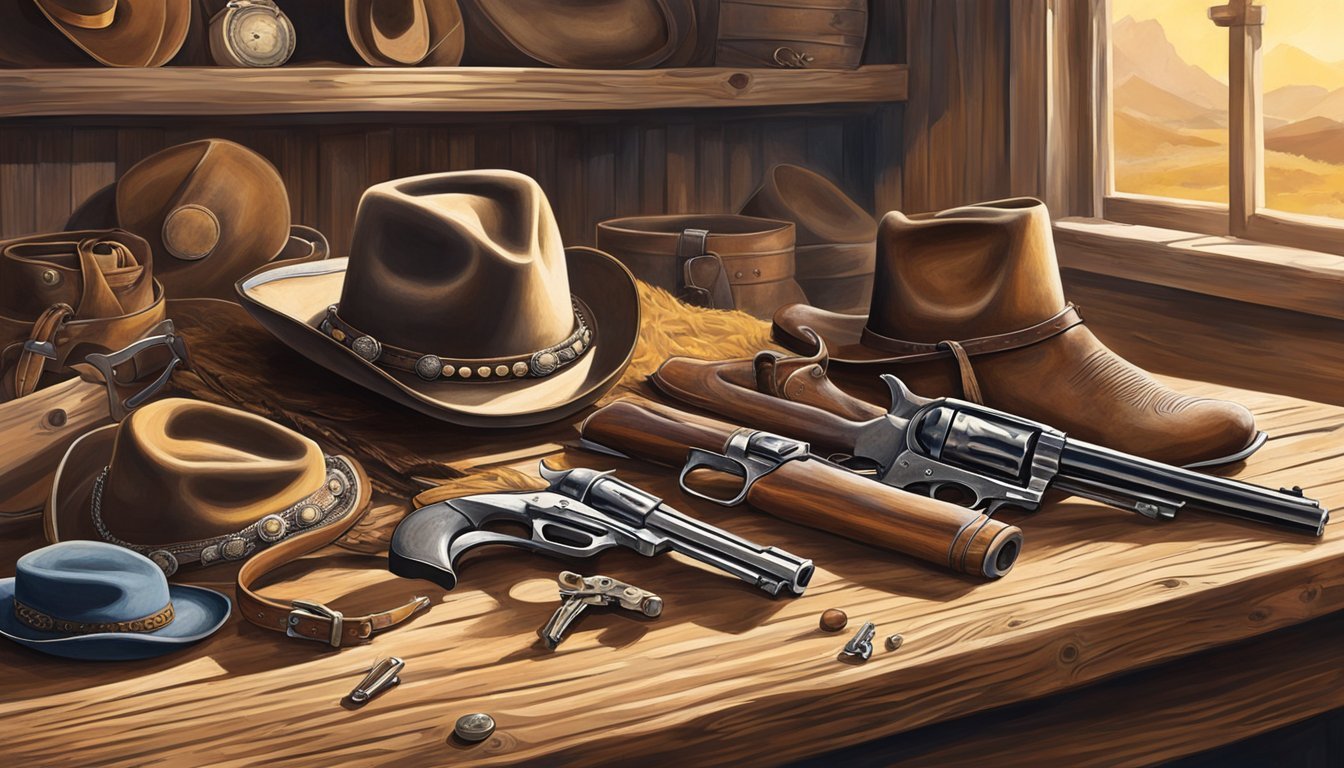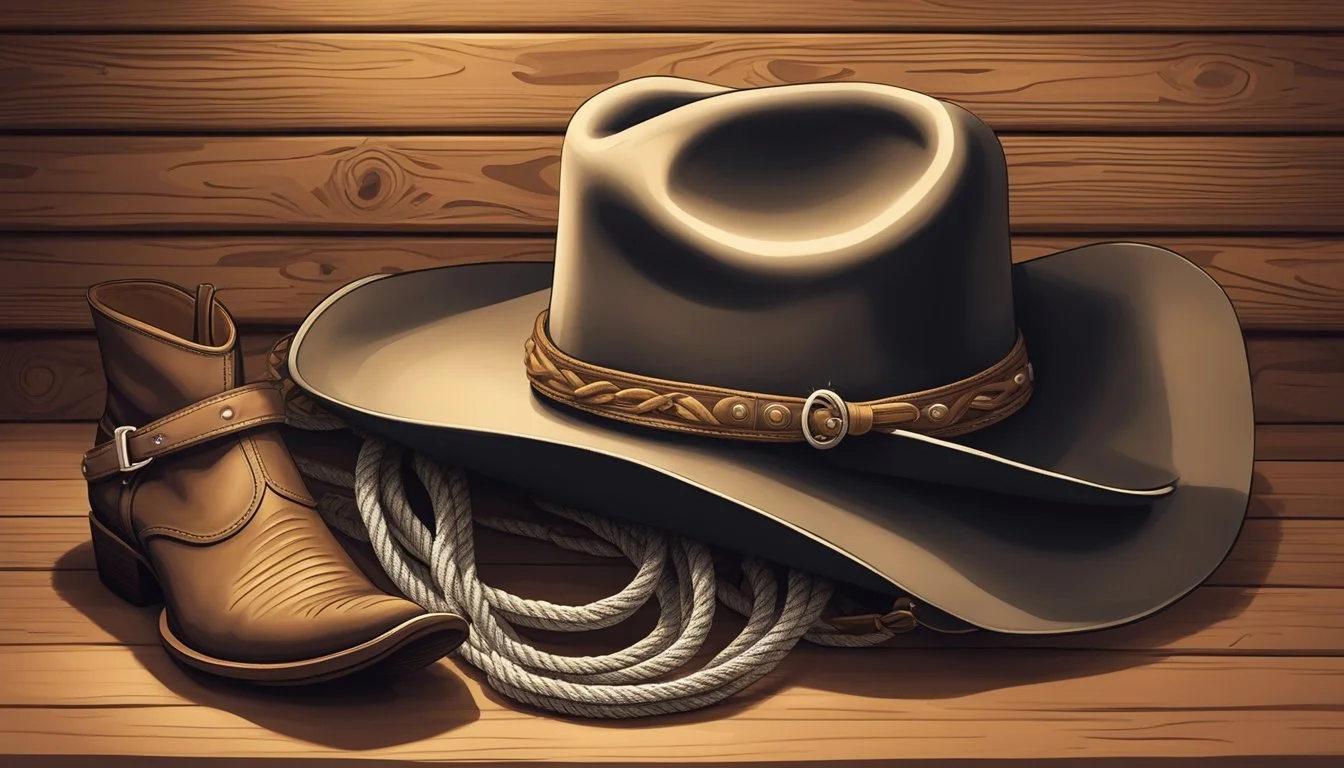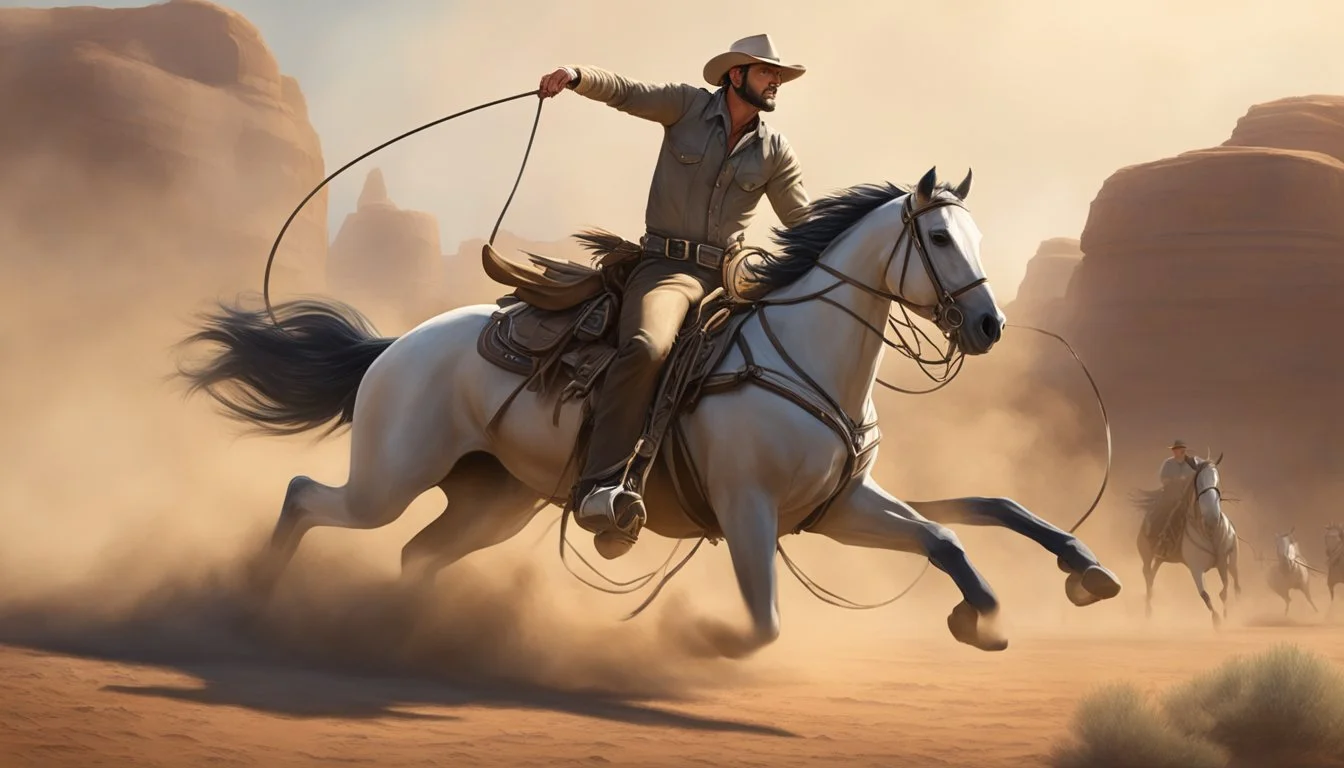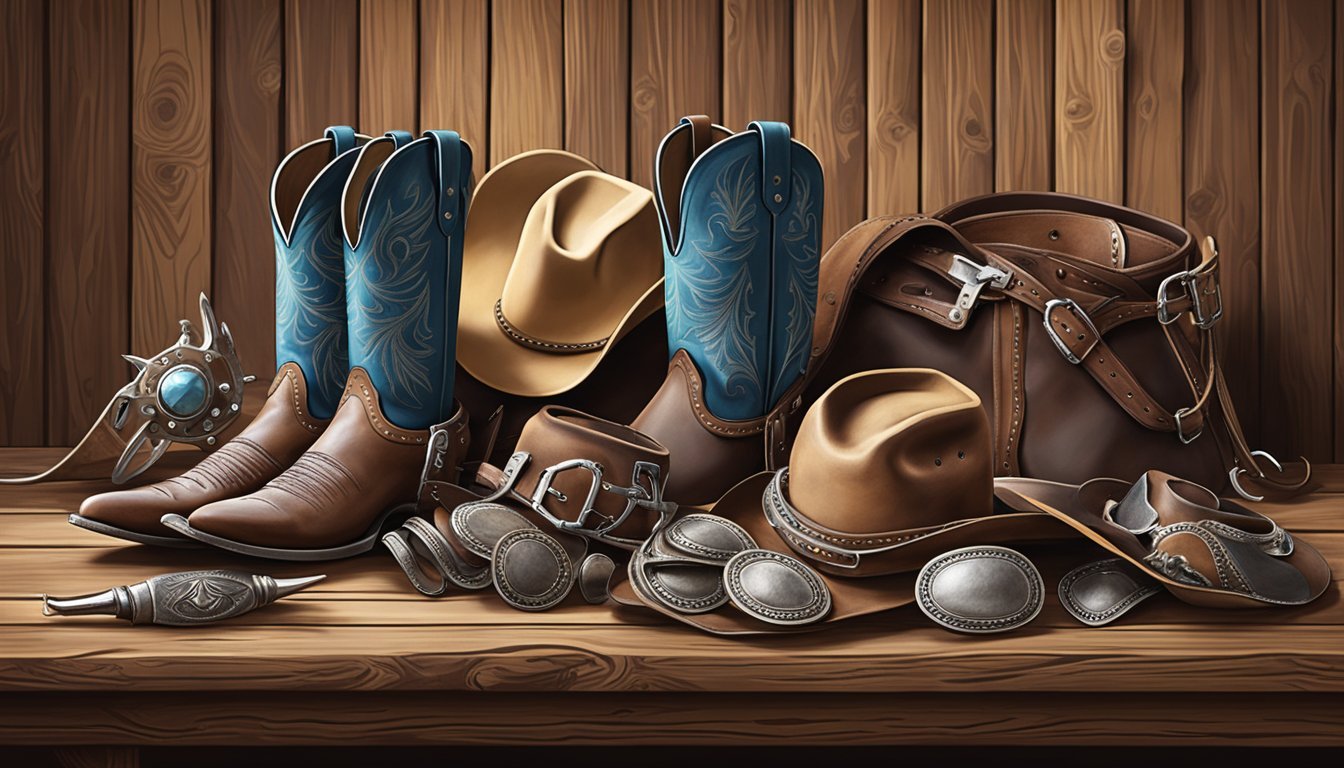A Guide to the Most Iconic Cowboy Gear
Essential Items of the Wild West
Cowboy gear has come to symbolize the rugged, independent spirit of the American West. This iconic ensemble is deeply rooted in the history and culture of the cowboys who shaped the old frontier. The most recognizable elements of this gear include lassos, spurs, and saddles, each with its own purpose and backstory. These tools were not mere accessories but vital for the everyday tasks and survival of the cowboys who spent long hours in the saddle, driving cattle, and navigating the vast landscapes of the West.
The lasso, or lariat, a looped rope that is synonymous with cowboy imagery, was an essential tool for catching livestock with remarkable precision. Originally made from rawhide and later from a variety of materials including modern synthetics, the lasso was a testimony to a cowboy's skill. Spurs, on the other hand, served as a means of effectively communicating with their horses. With styles ranging from the simple rowel spurs to the more elaborate shank design, they reflect a history that intersects with the age of chivalry where spurs were also a status symbol.
The evolution of cowboy gear is a story of practicality and innovation, as demonstrated by changes in how lariats were attached—from horse's tails in the early days to being wrapped around the horn of heavy saddles by the Vaqueros. Cowboys' apparel and accessories, shaped by the demands of their work and environment, have left an indelible mark on American culture, encapsulating the enduring legacy of the frontier era.
The Evolution of Cowboy Gear
Cowboy gear has undergone significant transformation from its historical origins to the modern-day rodeo. It reflects a unique amalgamation of cultural influences and practical adaptations suited to the needs of the American cowboy.
Historical Significance
The Old West era profoundly shaped cowboy culture, which emerged from the practical requirements of cattle herding and ranch work. Cowboy gear played a vital role in the day-to-day operations of cattle herders, known for its functionality and resilience against harsh environments.
Spurs: Inspired by the knights of the Middle Ages and derived from Celts, Greeks, and Conquistadors, spurs were essential for directing horses with greater precision.
Chaps: Adapted from the armor worn by knights and the protective garments of Mexican vaqueros, chaps provided leg protection against the elements and brush.
Lassos: Originating from the rope skills of Spanish herders and influenced by vaqueros from Mexico, lassos became a symbol of the cowboy's ability to capture and control cattle.
The gear's evolution is rooted in functionality, created to withstand the rigors of open range work while carrying an air of individualism reflective of the American spirit.
Influences from Ancient Civilizations to Modern Times
Cowboy gear evolved over centuries, drawing from various cultures and periods. The gear embraced elements from ancient civilizations, conquistadors, and European nations like England and France, culminating in the tools and attire distinctive to the American cowboy.
Saddles: While ancient saddles were basic, the modern cowboy saddle incorporated design improvements from the vaqueros and knights, enhancing comfort and utility for long hours on horseback.
Hats: The iconic cowboy hat traces its roots to wide-brimmed styles from Mexico and adaptations from the European felt hats, crystallizing into the renowned ‘Stetson’ hat, a nod to both practicality and style.
Boots: The high-heeled boots worn by cowboys originated from the footwear of vaqueros and were designed to prevent the foot from slipping in stirrups.
Every piece of cowboy gear carries a narrative of cultural exchange, evolving through centuries into a cohesive set that is instantly recognizable and deeply entrenched in the iconography of the American frontier.
Iconic Apparel of the American Cowboy
The American cowboy is often recognized by two notable pieces of attire that define the Western wear aesthetic: the sturdy cowboy boots and the iconic cowboy hat. These elements are emblematic of cowboy culture and are fashioned not just for style but for practical utility.
Cowboy Boots
Materials
Cowboy boots are traditionally made from cowhide leather but can also be fashioned from more exotic materials such as alligator or snakeskin.
Design Features
Heel: The boots feature a high heel that helps secure the cowboy’s foot in the stirrups.
Toe Shape: The pointed toe design allows for easier insertion into the stirrup when mounting a horse.
Tall Shaft: The height of the boots protects the cowboy's lower legs from thorns and snakes.
Functionality
Durability and protection are paramount in the construction of cowboy boots. They are designed to withstand the rigors of ranch work and harsh outdoor conditions.
Cowboy Hats
Materials
The classic cowboy hat can be made from a variety of materials, including felted wool, straw, or even fur-based fabrics like beaver fur.
Southern States vs. Northern Regions
Hat Brim: In Southern states, the brim is wide to provide shade from the sun, while in Northern regions, a smaller brim is common.
Crown Shape: Various crown shapes such as the "Cattleman", the most common, with its creased crown and dented top, are prevalent.
Functional Aspects
The cowboy hat serves as both a shield from the sun's harsh rays and as protection against other elements like rain. The design of the hat also allows for better visibility on horseback.
In their unembellished form, cowboy boots and hats served as the fundamental gear for the cowboys of the Old West. With time, these utilitarian components have transformed into stylish elements of modern Western clothing, encapsulating the rugged and adventurous spirit of the original wearers.
Essential Riding Equipment
In the realm of cowboy gear, certain items are indispensable for the effective handling of ranch work and herding cattle. The right equipment ensures both the cowboy's safety and the efficient management of livestock. The following is a breakdown of the crucial riding equipment used by cowboys.
Saddles
A saddle is foundational to a cowboy's riding equipment. It serves as the primary point of contact between rider and horse, offering stability and comfort for long hours of work. Key components of a saddle include the seat, which comes in various sizes to fit both the rider and the type of horse; the stirrups, adjustable to accommodate leg length; and the horn, which is essential for tying off a lasso when herding cattle.
Bridles
The bridle is a critical piece of equipment for controlling a horse. It consists of a headstall that holds a bit in the horse's mouth, attached to the reins the cowboy uses for directing movements. The choice of bit, whether it be a snaffle, curb, or hackamore, can significantly affect the communication between cowboy and horse during a day's work.
Chaps
Chaps protect the cowboy's legs from the harsh elements of the working environment while on horseback. Often made from durable leather, chaps shield against the brush, barbed wire, and other obstacles encountered during ranch work. They come in various styles, such as shotgun for full leg coverage or batwing for increased air circulation and mobility, each designed for specific working conditions and personal preference.
Understanding Spurs
Spurs are an essential part of cowboy gear with a rich history and variety. They're crafted with precision and serve as tools for clear communication with the horse.
Types and Designs
Cowboy spurs come in numerous styles, each with its own design features tailored to the needs of the rider and the discipline. Rowel spurs are recognizable by their revolving wheel or rowel which can vary in size and the number of points. These are among the most common and serve a general purpose in rider-horse communication.
Western spurs often feature elaborate designs that can include classic motifs inspired by Spanish style and the American frontier. The arm length and the rowel size can be adjusted depending on the specific horse riding discipline, from the precise movements required in reining to the rugged demands of cattle work.
Materials and Craftsmanship
Spurs are traditionally made from metals such as steel, silver, gold, and brass. Craftsmanship can range from the purely functional to the artisanal, with attention to aesthetic aspects like engraving and inlay work.
Material Common Use Notable Feature Steel Everyday work Durability Silver Show spurs Shine and intricate designs Gold High-end custom spurs Luxurious appearance Brass Variety of spurs Muted shimmer
Intricate designs are often hand-engraved, and in some cases, craftsmen inlay precious metals for more decorative spurs, often worn in competitions or special occasions.
Function and Communication
The primary purpose of spurs is for the rider to provide cues and subtle signals to the horse. The design of the spur, from the length of the arm to the size of the rowel, affects the clarity and specificity of these signals. Different styles can apply more or less pressure, and the skilled use of spurs can greatly enhance communication between the rider and the horse, ensuring swift and precise actions during various disciplines.
Horsemanship and Riding Styles
Within the iconic cowboy gear repertoire, the relationship between the rider and their horse is pivotal, and it's embodied in their horsemanship and riding styles. This section explores the nuanced world of horse and cattle handling, shedding light on the techniques that define the quintessential cowboy.
Roping Techniques
Cowboys use a variety of roping techniques tailored to the situation at hand. Overhand throws and honda slides are two methods often used during cattle roundups. These methods rely on precision and timing, with the cowboy swinging the lasso above their head in a flat loop before releasing it toward the intended target.
Overhand Throw: A basic yet versatile technique where the rope is swung from front to back.
Honda Slide: In this method, the roper allows the loop to slide and tighten around the honda for swift catches.
Cattle Herding Strategies
Effective cattle herding is a cornerstone of cowboy riding styles, where riders must exhibit control and assertiveness.
Cutting: This strategy involves separating a single animal from the herd, often utilizing a well-trained horse that responds to subtle leg cues.
The Blocking Technique: Here, riders position their horses to steer the movement of cattle, preventing them from straying.
In both techniques, the horse's sensitivity to cues is crucial for the smooth execution of the strategy.
Horse Training and Riding Disciplines
Training underpins the ability of a horse to perform across various disciplines. Cowboys often draw on methods similar to dressage to increase responsiveness and agility.
Reining: Involves guiding the horse through a precise pattern of circles, spins, and stops, all executed with little apparent effort.
Trail Riding: Training for this discipline includes exposure to varied terrain and obstacles to build confidence and trust between the horse and rider.
During this meticulous training, riders foster a deep bond with their horses, developing mounts that can interpret a range of commands from pressure cues to verbal prompts.
Communication and Commands
In the context of cowboy gear, communication and commands refer to the interaction between the cowboy and their horse. This section explores the crucial equipment that facilitates this communication, ensuring commands are delivered efficiently and effectively.
The Role of Spurs in Commanding
Spurs serve as a traditional tool for communicating commands from rider to horse. These metal instruments are attached to the heels of a cowboy's boots and can vary in design. A common feature is the rowel, a small wheel with points that gently rolls against the horse's sides to signal different commands. Riders can apply different levels of pressure and specific movements to guide the horse, emphasizing the importance of trust and understanding between horse and rider to prevent distress and miscommunication.
Subtle Cues between Horse and Rider
Communication between horse and rider is often composed of subtle cues that form a silent language of their own. Cues can include slight shifts in the rider's weight, minimal leg pressure, or even a change in the rider's posture. Every gesture carries meaning, and a well-trained horse can discern and respond to these signals with precision. This trust-based interaction showcases how integral the relationship between horse and rider is to the seamless execution of rodeo events and cattle handling. Effective command execution relies on this nuanced form of communication, built over time through consistency and patience.
Cowboy Accessories and Decorations
Cowboy gear is as functional as it is symbolic, with items like spur straps and various other decorative elements serving as testament to the cowboy's occupation and personal style.
Spur Straps and Rowels
Spur Straps:
Brands like Ariat design durable spur straps that not only secure the spur to a cowboy's boot but also add an element of style.
Materials: Typically made of high-quality leather to withstand the wear and tear of ranch work.
Rowels:
Function: The revolving wheel with points, or rowel, at the spur's end is crucial for signaling a horse.
Variations: Shapes and sizes of rowels differ to provide various levels of encouragement to the horse.
Decorative Elements
Chap Guard and Heel Band:
The heel band of a spur cradles the boot's heel and can be adorned with intricate patterns or silverwork.
A chap guard prevents the spurs from getting entangled in the chaps, often matching the spur's decorative theme.
Jingle-Bobs:
Purpose: These small dangling pieces called jingle-bobs can be attached to the rowel to add an audible jingle with each step.
Personalization: Cowboys often customize their spurs with jingle-bobs to express their individuality.
Accessories play a significant role in defining the cowboy look and are chosen carefully for both appearance and practical use.
Contemporary Cowboy Gear Makers
The crafting of cowboy gear is an art steeped in history yet continuously evolving to meet modern demands. Today's artisans blend time-honored techniques with new materials and designs to create equipment that resonates with both tradition and innovation.
Innovation and Tradition
Contemporary gear makers are recognized for their meticulous craftsmanship and attention to detail. Artisans like Buddy Knight stand as pillars of quality, creating items such as Texas-style spurs with sterling silver overlay, which are as functional as they are aesthetically pleasing. These makers often draw on their own experience within cowboy culture to inform their designs, ensuring that the gear is fit for actual working conditions.
Materials: Modern makers utilize a variety of materials, from cold rolled steel to fine leathers and new, durable synthetics, which maintain the gear's integrity and provide longevity.
Techniques: While staying true to the essence of classic designs, contemporary craftspeople also incorporate modern tools and techniques. Laser cutting and computer-aided design (CAD) are just a couple of the advancements aiding in precision and consistency of their work.
Stylistic Elements: Today's artisanal gear often features intricate hand-worked details, a testament to each item's bespoke nature. Unique stylistic elements are not just decorative; they carry the signature of their maker, much like a work of art.
Functionality Meets Design: Utilitarian purposes are paramount, but aesthetic appeal plays a significant role. Items must perform under rigorous conditions, yet many contemporary makers also focus on creating visually striking pieces that could be considered collectibles.
As a result, these contemporary gear makers do not just preserve the cowboy legacy; they carry it forward, blending the gritty practicality of the cowboy ethos with the elegance of modern artisanship.
Cowboy Gear Size and Fit
In selecting cowboy gear, the importance of size and fit cannot be overstated. Properly sized equipment ensures not only comfort but also safety during wear and use. This section focuses on how to achieve a secure fit, taking into account the unique aspects of specific gear.
Ensuring a Secure Fit
Cowboy Hats: The fit of a cowboy hat is critical; it should sit snugly on the head without being overly tight. A good fit keeps the hat straight on the head without slippage, even during active movement.
Boots: Cowboy boots should fit securely around the foot, with enough room to wiggle the toes but not enough to slide the foot forward and back. The boots must also provide ankle support, conducive to activities requiring swift movements.
Spurs: Spurs come with varied shank lengths and rowel sizes. A secure fit means:
Straight shanks: Ideal for those with longer legs, ensuring the spur sits appropriately without affecting the rider's balance.
Curved shanks: These are better for individuals with shorter legs, allowing easier contact without strain.
Lassos: The lasso, while not worn, must feel balanced and comfortable in the hand. Its size directly relates to the intended usage, where a secure grip ensures precision and safety during roping activities.
When focusing on size and fit for any cowboy gear, one must consider not only the measurements but also the practical use to which each item will be put. This ensures gear that feels like a natural extension of the cowboy's own movements and style.
The Influence of Cowboy Gear on Modern Fashion
Cowboy gear has not only defined the American cowboy and cowgirl but has also left an indelible mark on modern fashion trends, blending durability with unique style.
Western Wear and Popular Culture
Western wear's journey into popular culture and high fashion is a testament to its enduring appeal. Key pieces of traditional cowboy attire, such as denim jeans, cowboy boots, and wide-brimmed hats, have transcended their utilitarian roots to become staples in contemporary wardrobes. Celebrities are often seen incorporating these elements into their outfits, giving rise to a renewed interest in Western aesthetics.
Cowboy Boots: Once designed for horseback riding and ranch work, cowboy boots have strutted onto the runway and urban streets alike. Luxurious materials like snakeskin, as noted by GQ, have elevated these boots into high-fashion items.
Denim: Originally the fabric of choice for its hard-wearing properties, denim has become synonymous with American fashion. Cowboy pants, notably jeans, offer a combination of comfort and resilience that has been embraced globally.
Cowboy Hats: The iconic cowboy hat, as per Vogue, is no longer just for shielding from the sun on the prairie but is now a bold fashion statement in cities worldwide.
Western Shirts: Retailers like Wrangler have modernized the snap-front Western shirt, maintaining authentic details while tailoring them for a contemporary slim fit. This piece remains a favorite for adding a touch of Western flair to an ensemble.
In essence, these elements of cowboy gear have been seamlessly integrated into modern fashion, often observed on catwalks, in streetwear, and at high-profile events. They exemplify a rugged yet chic aesthetic that continues to evolve, capturing the spirit of the American West while appealing to a broad, style-conscious audience.
Caring for and Maintaining Cowboy Gear
Maintaining cowboy gear is crucial for both the longevity of the items and the preservation of Western traditions. Proper care ensures that materials retain their quality and accessories function as intended.
Longevity of Gear
Materials: Cowboy gear is often made from durable materials like leather, which requires regular conditioning to prevent cracking and drying. Saddle soap can clean leather effectively, while mink oil or leather conditioner keeps it supple.
Boots: Regular polishing and the use of cedar boot trees can maintain their shape and finish.
Rowel: On spurs, the rowel should be kept free of rust and frequently checked for smooth rotation, as it can affect the spur's functionality.
Accessories: Items such as belts and holsters benefit from occasional leather treatment. Metal parts should be wiped with a soft cloth after use to prevent tarnish.
Maintenance Tips:
Gear Piece Maintenance Action Leather Chaps Clean with damp cloth; condition with leather conditioner Cowboy Hats Brush out dirt; store in a cool, dry place
Preservation of Tradition
The care of cowboy gear is not merely a matter of function—it is also about honoring the cowboy legacy. Each piece, from the spur rowel to the hand-tooled leather belt, carries a piece of history.
The right care maintains the gear's aesthetic, critical for traditional events such as rodeos.
Repairing gear rather than replacing it often retains original craftsmanship, preserving the unique handiwork passed down through generations.
Conclusion
Cowboy gear such as spurs and lassos embodies a rich heritage reflecting the practical needs and the culture of the American West. Spurs, while once a symbol of rank and chivalry, have become an essential tool for communication between rider and horse. Collectors and cowboys alike cherish them for their historical value and functionality. Modern-day spurs may rival antiques in craftsmanship, showing the enduring nature of this tradition.
Lassos, or lariats, display versatility and skill in use. Whether fashioned from rawhide or synthetic materials, their design serves the specific task of roping cattle with precision. Cowboys employ these iconic looped ropes with a technique reflecting years of honed skill, integral to rodeo events and cattle work.
Saddles have evolved alongside other cowboy gear. The Western saddle incorporates the ability to secure a lasso during cattle roping, highlighting the synergy between cowboy tools.
The utilitarian nature of these items ensures their continued relevance. Even as the world changes, the demand for high-quality, functional gear remains, upheld by those who value the history and ongoing story of cowboys. Traditional craftsmanship continues to be celebrated, and contemporary artisans maintain the integrity of this cultural legacy.









